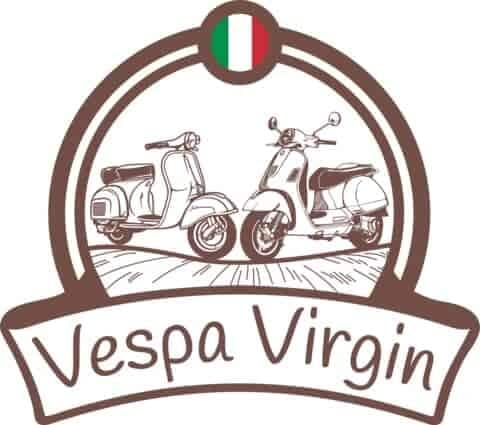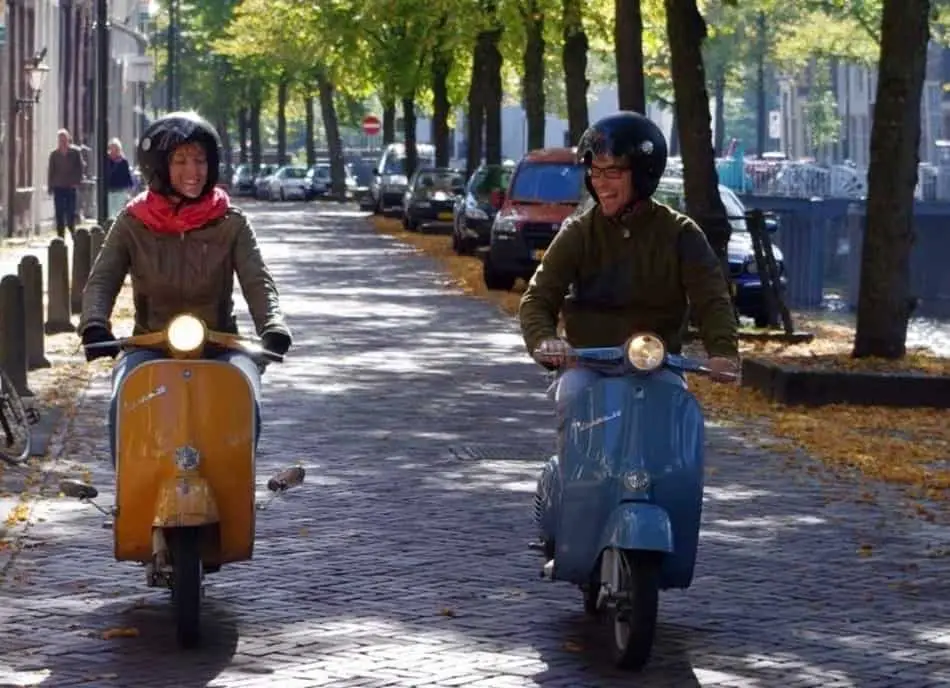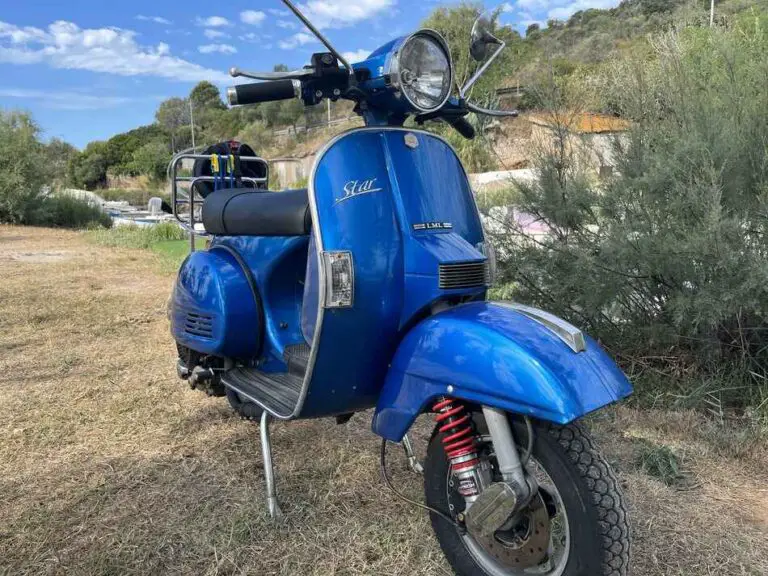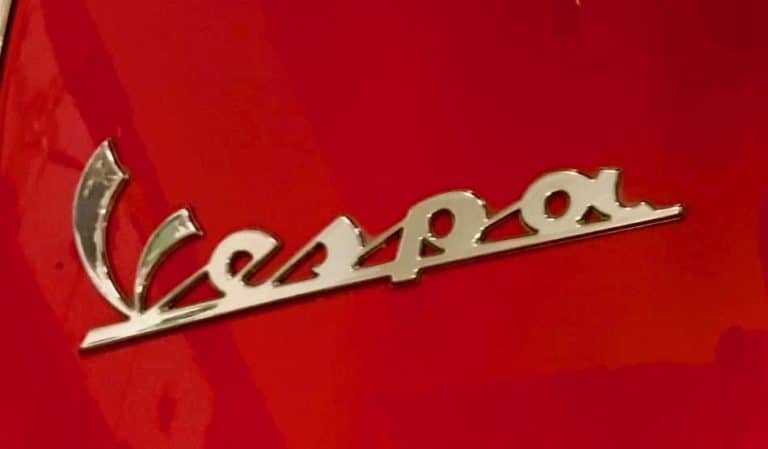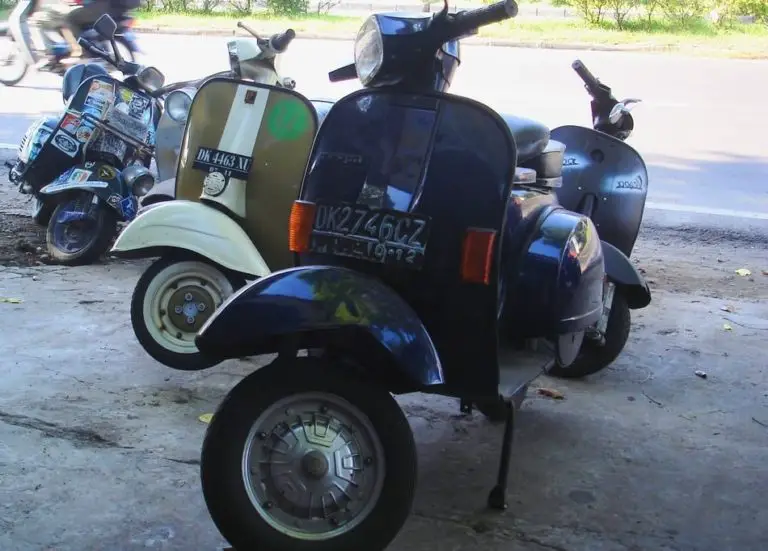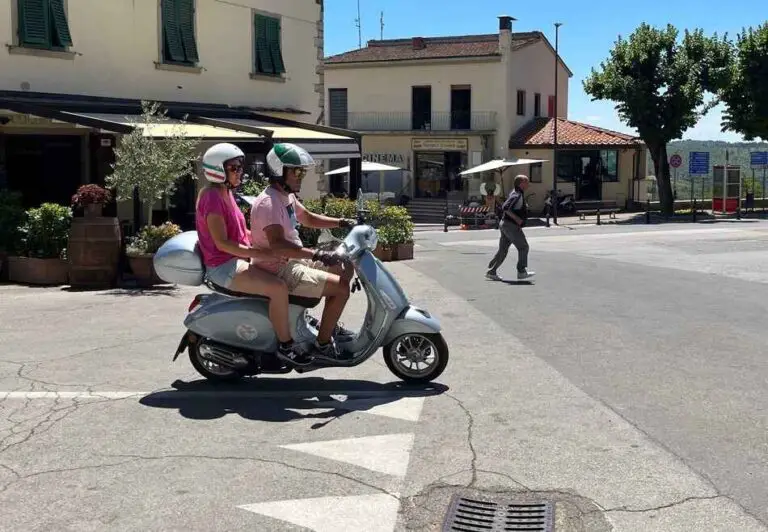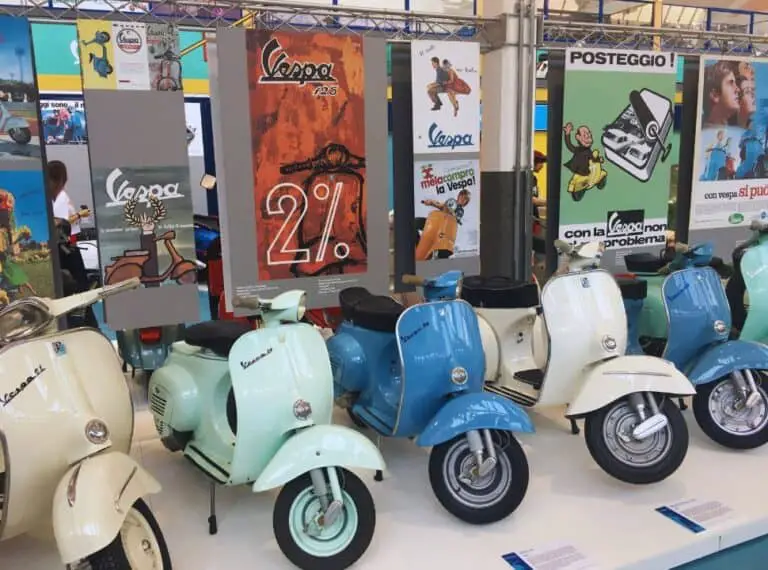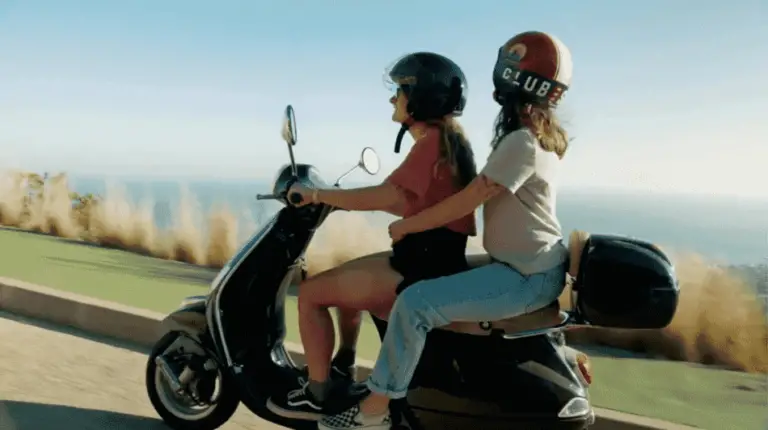8 Reasons Why Vespa Is So Popular
While many types of motor scooters come and go, Vespa has always stayed strong. Piaggio launched its first Vespa in 1946 and today it is the oldest scooter model that is still sold on the market. In 2016 they celebrated their 70th anniversary by launching the new Primavera. One of the most successful Vespa models of all time.
Piaggio has always adapted to the wishes of their target group. The Vespa brought a sense of freedom and along with, practicality, innovation, and something beautiful to look at. And these are still the winning points of a Vespa.
Over the years Piaggio has been successful in putting this iconic scooter on the market. The 8 reasons that have made the Vespa so popular are:
1. A Vespa frame is different than a motorbike
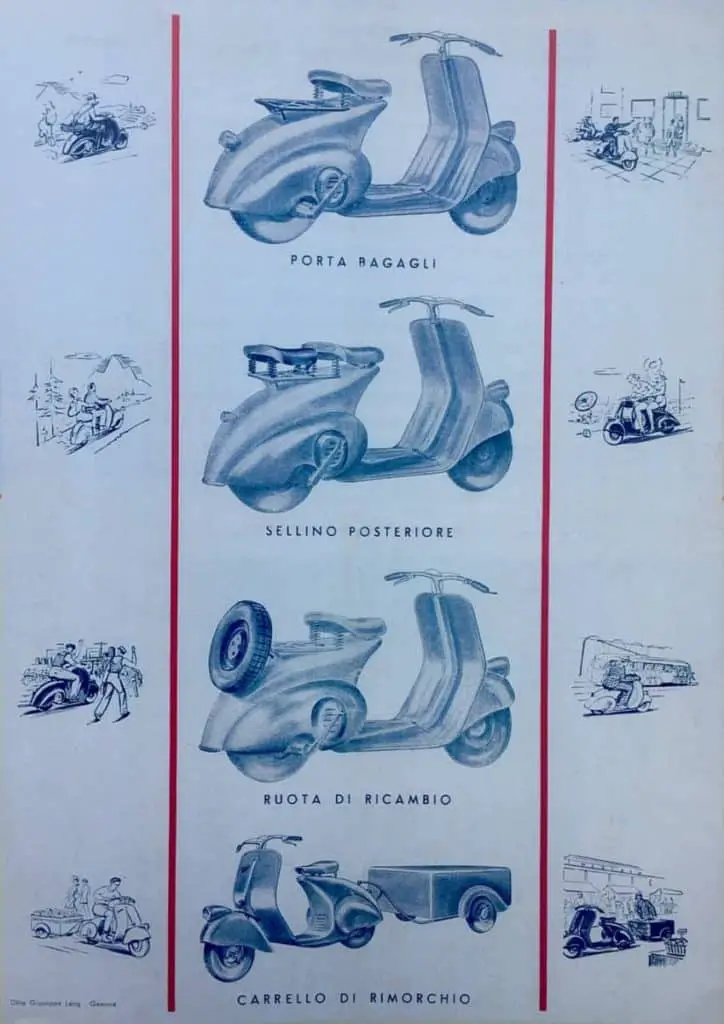
Right after WWII, the former military plane manufacturer Enrico Piaggio wanted to start his business again. At that time Italy was still recovering from the war. So he wanted to create a practical low-cost product that was accessible to every Italian. His designer Renzo Spolti created the motor-scooter MP5 that was nicknamed Paperino (Donald Duck) by his co-workers.
While the design wasn’t to Enrico Piaggio’s liking, the idea was set. He asked the aeronautical engineer Corradino D’Ascanio to come up with a new design: ‘a two-wheeled vehicle that was extremely simple, cheap, absolutely utilitarian and unisex‘. And that is what D’Ascanio did.
The unfamiliarity with motorcycles enabled D’Ascanio to make something different. He focused on the following points and incorporated some of this aerodynamics knowledge when creating the first Vespa prototype MP6:
- easy to get on – the woman’s bicycle frame was used as an example for Vespa’s step-through frame
- easy to maneuver for urban use – both hands should be on the handlebar when riding, so the gearshift was placed there
- the driver should stay clean – unlike most motorbikes, the Vespa got an enclosed engine
- mono-strut support for the front wheel – instead of a bicycle-derived fork, the Vespa got something similar to that of the front wheel of a plane
- changing the wheel should be easy – a Vespa should not be stranded for just a punctured wheel. Just like a car, the wheel can be changed on the spot
- monocoque body – the body of a Vespa is similar to a car, not made from separate parts. This makes it stronger..
“Not a motorcycle, but rather a small two-wheeled car”
1946
The Vespa 98 was the first Vespa to be launched by Piaggio in 1946. While people were used to the traditionally built motorcycle, it was first received by skepticism. But once people saw how it performed, it was an immediate success. Owners of a Vespa were now known as Vespista.
The Vespa was loved for its non-sporting style, it was economical, the Italians has a sense of freedom of owning their own transportation and up-to-date styling. The motorscooter was also easier to handle making it perfect for those who had never ridden before.
2. Vespa always has an up-to-date design
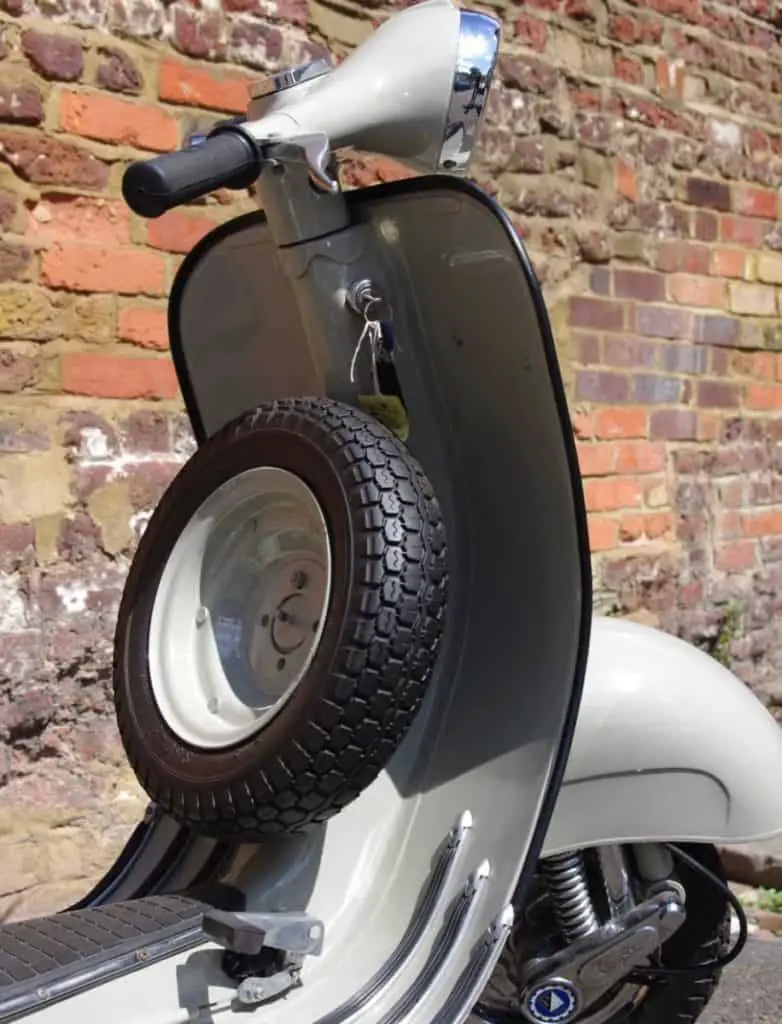
Piaggio has always stayed true to the design of their first Vespa. In the last 75 years, Piaggio has launched 20 types of Vespa models, each one adapting to the current trends and wishes of their market group of that time.
We have highlighted what the successful changes in design were for the Vespa:
1950’s – The Vespa U (Utilitaria) was a ‘simple’ model that only had the bare basics. By doing so, costs could be saved making it more accessible for more Italians to purchase a Vespa.
1960 – In these years Piaggio introduced two types of Vespas: the large frame (Vespone) and the small frame (Vespino). The Vespa 50 with a 55cc engine displacement was targeted for 14-year-olds and it was a success. The Vespa Super Sprint was again popular for its somewhat different style compared to previous models: smooth styling, front mudguard was lighter and the shape of the shield was slightly different. The Vespa 180 SS was a success for its bright colors. And the Vespas GL was a hit as it was the first model with a 4-speed gearbox and 10″ wheels.
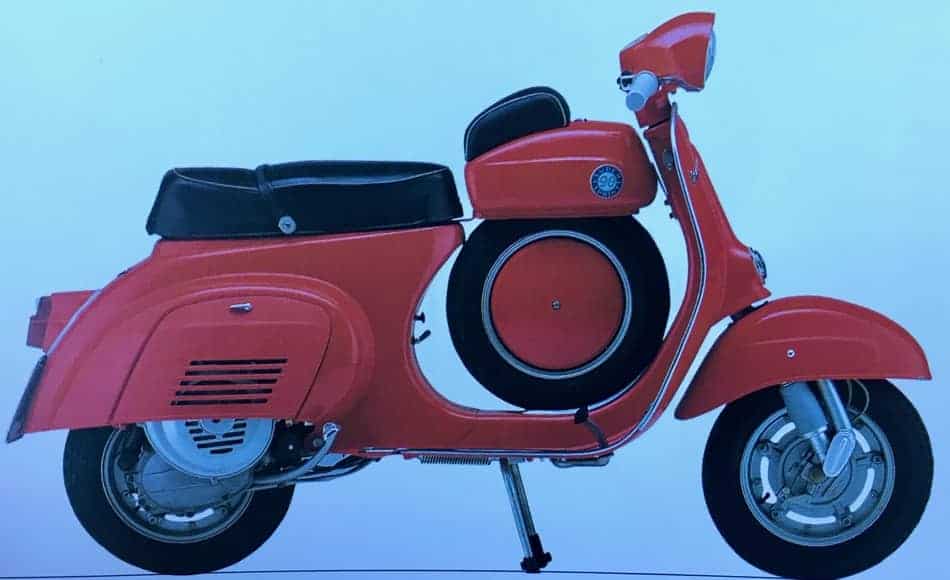
1970’s – The sleek lines of the small frame remained attractive. While 14-year-olds buzzed away on the Vespa 50 Special, the 16-year-olds fell for the Vespa 125 Primavera. Both models came in bright colors such as green and orange. The Primavera ET3 had a sporty look with graphic lines on its side panels.
The large frame models were considered outdated compared to the Primavera. Only the 200 Rally was appreciated for its sporty looks and being the fastest Vespa.
1980’s – It was difficult to exceed the success of the Primavera. The PK small frame series was therefore not a success. The model with its rough edges just didn’t look attractive. Fortunately, the large frame PX series was a bigger success for the incorporation of indicators in the bodywork.
1990’s – Piaggio tried to solve its PK design mistakes in the 1980s and started to soften the edges making it somewhat more attractive again. It wasn’t the most appreciated model however the public did welcome the increase of additional instruments on the scooter, such as a speedometer and tell-tale light.
The new Cosa large frame was a big fail despite improved technology. It couldn’t win the success of the PX. The rear of the Cosa Vespa model was one of the worst designs. Luckily Piaggio returned with the Vespa ET, the first 4- stroke Vespa. The elegant lines were visible again in this Vespa model.
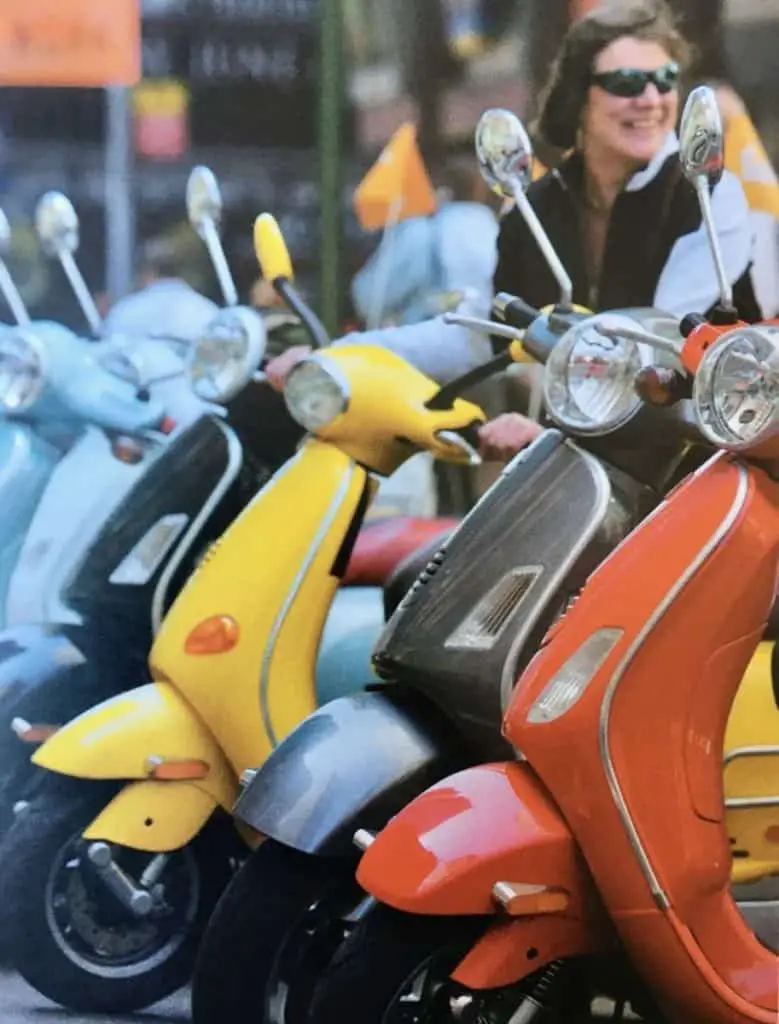
2000’s – The stylish Vespa LX replaced the successful Vespa ET. It came in a 50cc 2 and 4-stroke, 125 cc, and 150cc 4-stroke engine. It showed that Piaggio was adjusting to the current market. Evolving from the Vespa LX, there was the Vespa S and Vespa GTS 300 Super. Both sporty-looking Vespas. The Vespa S particularly appealed to the younger public.
2010’s – The return of the successful Primavera together with the sportier version of the Vespa Sprint. The modern Vespa looks elegant and stylish. The lines are bolder and up to date compared to the LX models. Vespa 946.
2020’s – After 20 years the Vespa models haven’t changed much compared to the previous 10 years. The lines are still smooth with a modern look, especially the rear. The Primavera, Sprint and Elettrica design are still lovable, while the GTS is still the robust looking Vespa. However now these models comes in all kinds of bright colours. The Electrica is still silver, but you are able to personalise it by changing the colour of the strip.
3. The marketing of the Vespa is always original
Not only did the design of Vespa evolve with the current trends but the marketing campaigns were also updated. Initially, Piaggio ensured that their product was associated with practicality. The image of getting around easily was created, especially among women. Piaggio used several ads with women buzzing through town, fashionably dressed on their way to work.
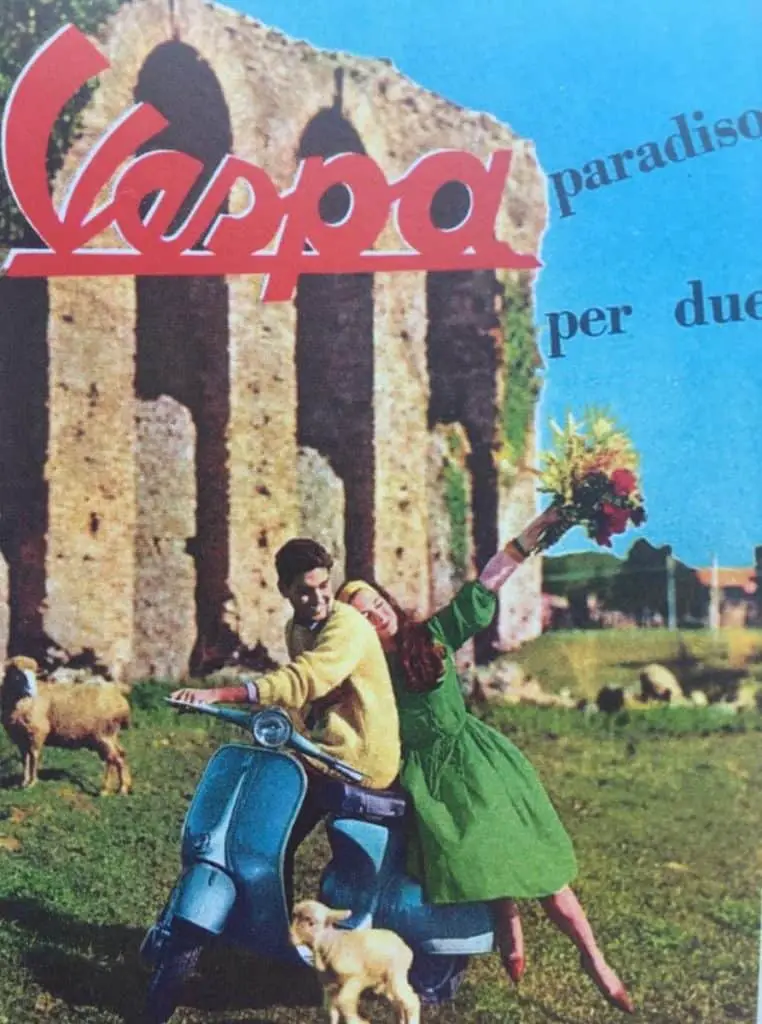
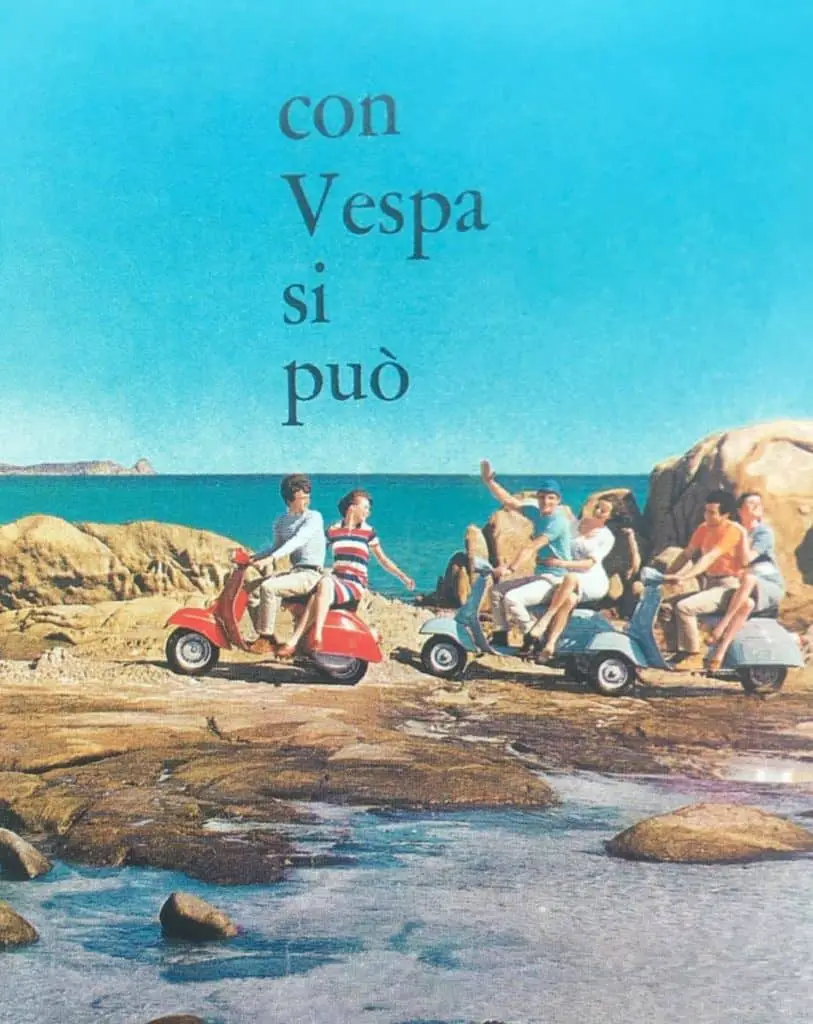
In post-war Italy, everything was about practicality and economics. In the 1950s the essence of Piaggio’s marketing started to focus on fun and freedom. They did this by picturing Vespas with teenagers hanging out after school, couples going for a picnic in the countryside, and years later, the easiness of driving through traffic.
“Vespizzatevi“! – ‘Vesparize yourselves’/ Let’s Vespa
1950
Piaggio has always emphasized the needs of their riders by showing fun images and playing with words to create catchy slogans. Here are just a few examples:
1960 TRAFFICO! con la Vespa mon e’un problema – Traffic with a Vespa isn’t a problem.
1970 Chi Vespa mangia le mele (chi non Vespa no) – S/he who rides a Vespa eats apples. S/he who does not ride a vespa doesn’t.
With the increase in traffic and the awareness of pollution, Vespa created a new word ‘sardomobili’ which describes cars stuck in traffic as sardines in a tin.
While in the USA they used ‘ Perhaps you next car shouldn’t be a car’.
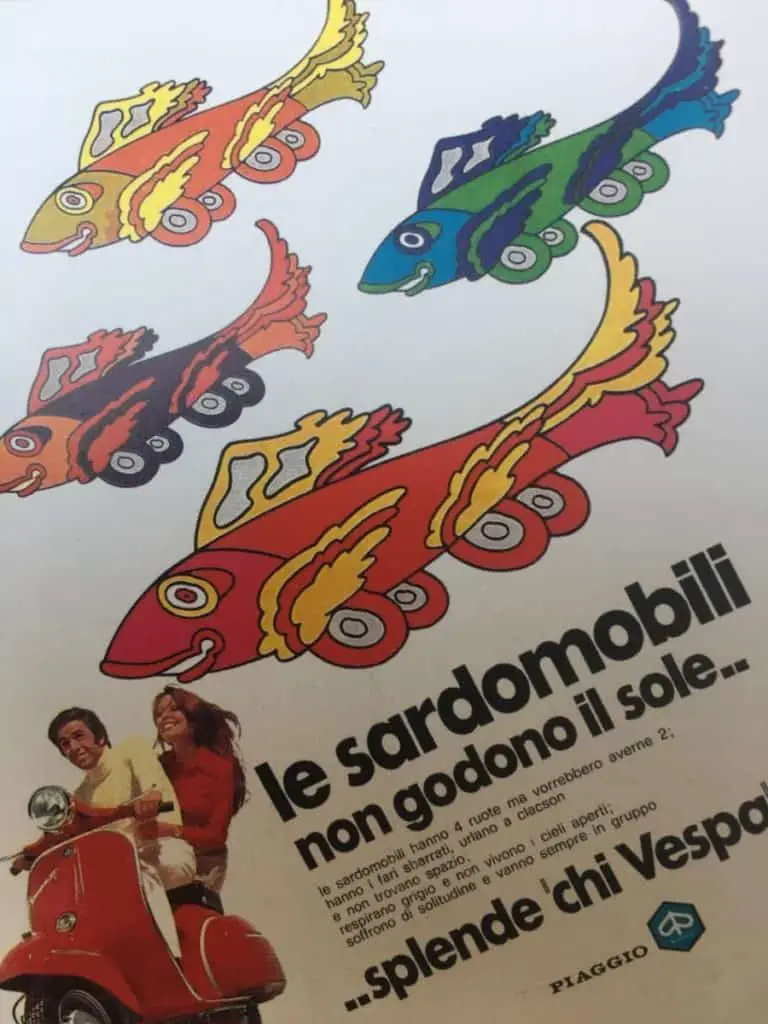
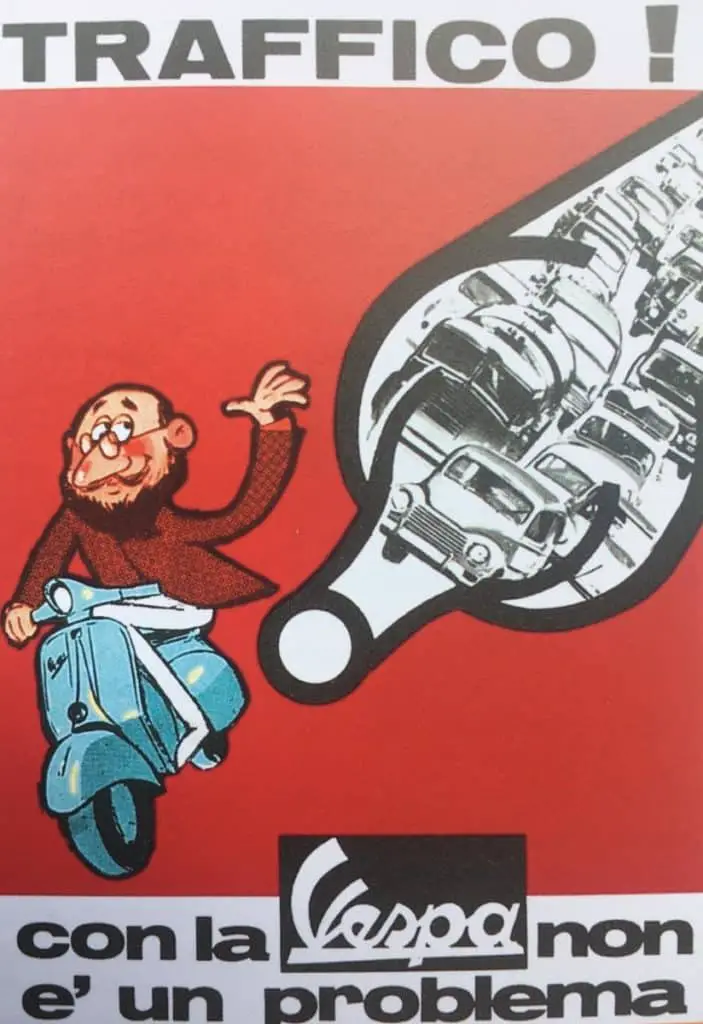
When Italy won the World Cup in 1982 Piaggio changed the second line of the national anthem from ‘L’Italia s’è desta’ (Italy has awakened) to ‘L’Italia s’è Vespa‘ (Italy has become a Vespa).
At the beginning of 2000, Piaggio managed to use the popularity of the internet. You could for instance buy a Vespa online. This was of course advertised with an ad that featured a woman who just ordered her Vespa with the text: ‘Hai appena acquisto la tua nuova Vespa tra une brioche e un cappuccino‘. – You just purchased your new Vespa between a bread/pastry and a cappuccino.
Towards 2010 Vespa focused on urban travel and the easy maneuverability in the city. Again, the sense of freedom is always being highlighted. With the new GTS models, Piaggio shows the adventurous side of a Vespa.
However, with other models, they seem to want to differentiate themself from other competitor scooter brands and highlight their unique style. For the Vespa 946 in 2013, Piaggio used ‘Are you entitled to be one of the lucky ones?” In 2014 Piaggio launched the Primavera with the slogan ‘Live more Vespa’.
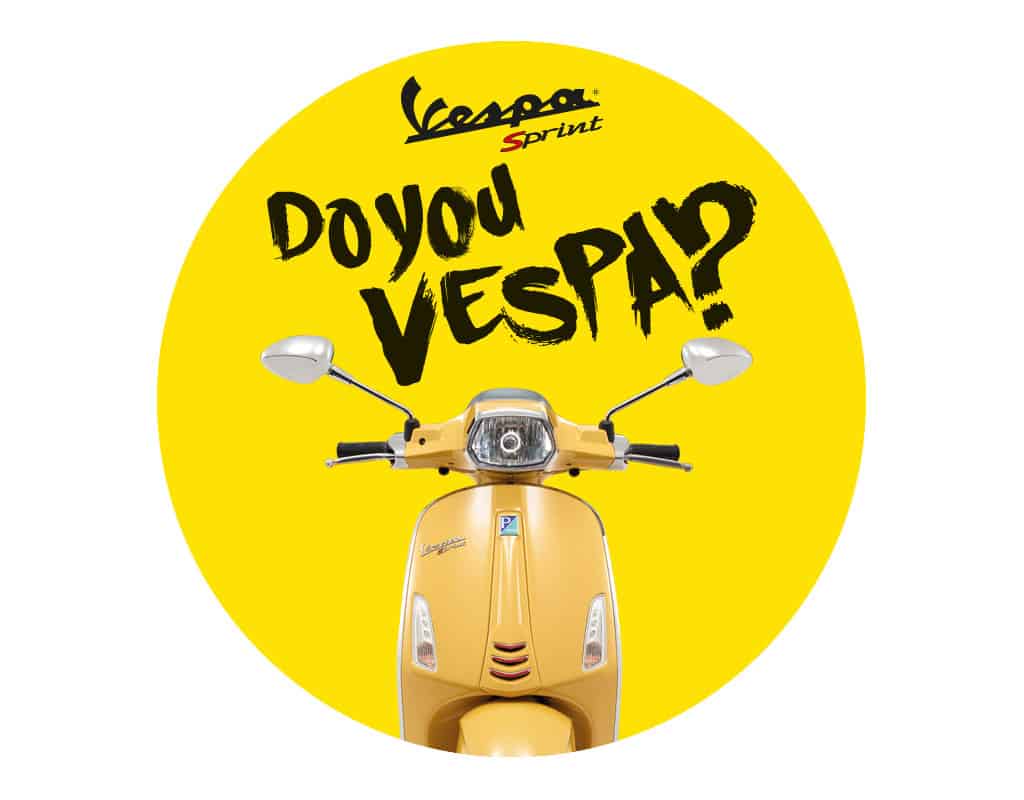
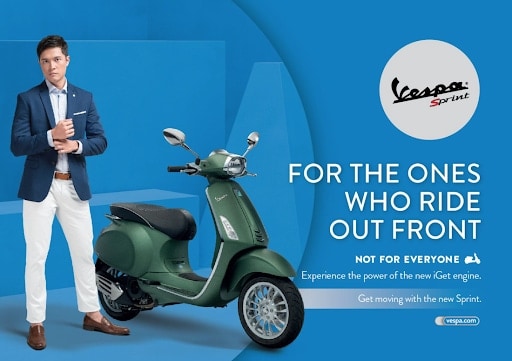
In South-East Asia where Vespa is upcoming the Primavera IGet 2017 was promoted with ‘Not for Everyone’ and ‘For those who believe in icons’. India focused more on the personality of the riders and aim at those who dare to stand out from the crowd and face challenges. They did this by asking ‘Do you Vespa?’ in their advertisements.
Smart enough, in the USA Piaggio focused more on the economical gain of having a Vespa. For New York they used:
‘We have one crazy word for crazy gas prices. Ciao’
2020
With the Vespa Electrica in 2020, Piaggio choose the slogan ‘I am the Power’, – Discover the power of silence’.
Again and again, Piaggio has been able to depict the Vespa in a way that the current public feels associated with it. With the COVID-19 lockdown being slowly lifted worldwide in 2021, Piaggio created a colorful marketing campaign that highlighted the return of normal life and of course freedom. They used their old successful slogan from the 1950’s ‘Vespizzatevi’, ‘Let’s Vespa’ with additional text such as ‘Happy to see you again’ and ‘Long time no see’.
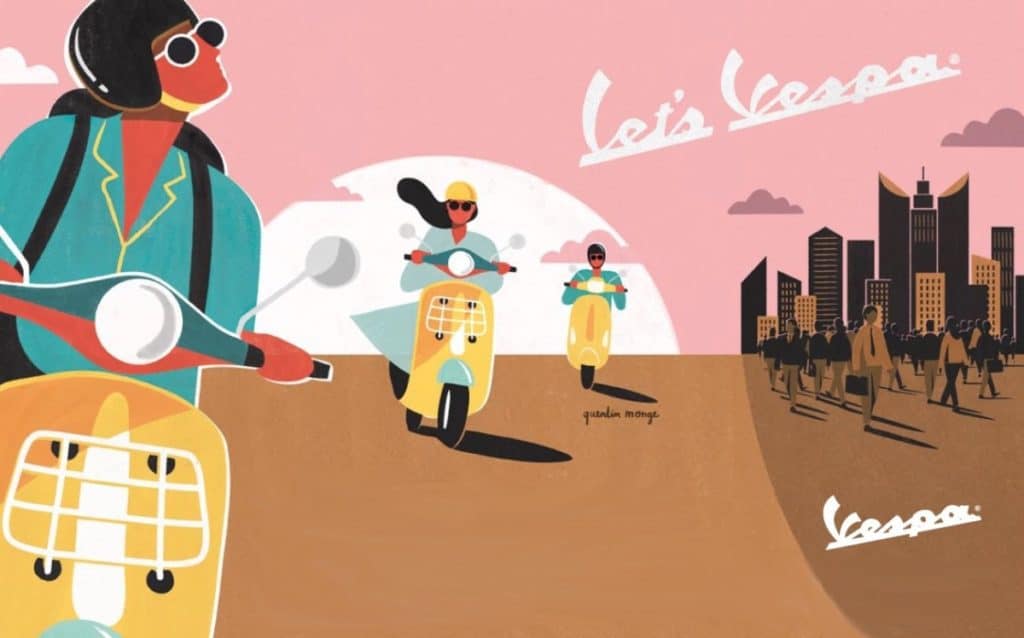
4. Vespa is featured in movies
Vespas have been used in movies soon after the birth of this iconic scooter. Many great Italian movies have used the Vespa as one of their vehicles. However, when the Vespa appeared in the movie ‘Roman Holiday’ (1953) starring Audrey Hepburn and Gregory Peck it became an instant hit. This was the first Hollywood movie in which Vespas appeared and when the whole world fell in love with this eye-catching vehicle.
Vespa appearances in movies and movie stars riding a Vespa are free advertisements. Over the years it has appeared in a long list of Hollywood and Bollywood movies. We have listed just some of the movies including the actors who were riding the Vespa.
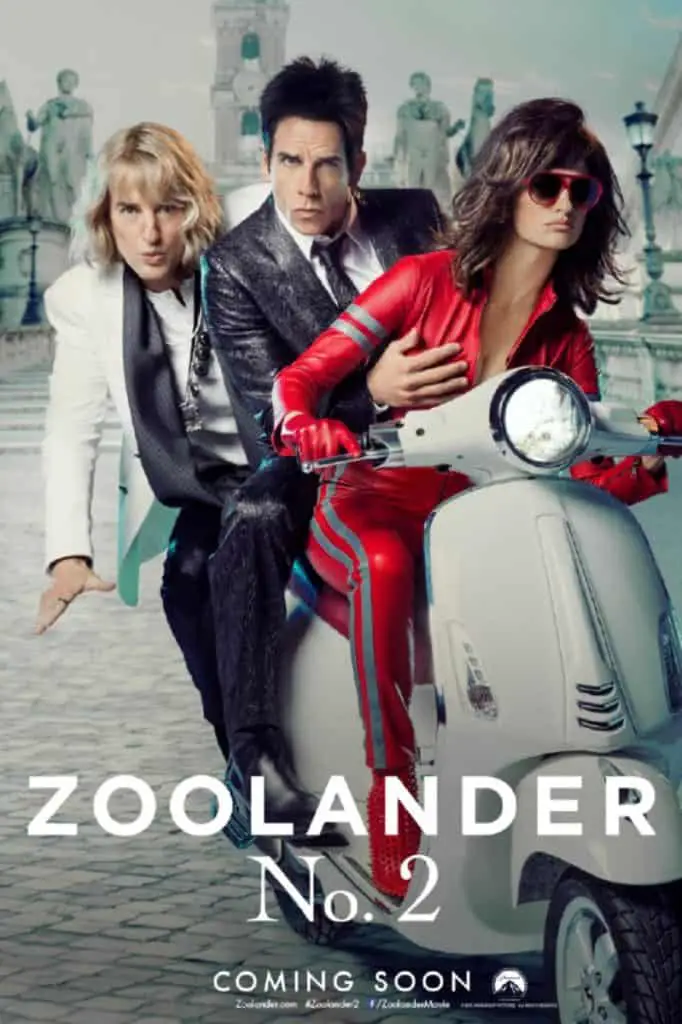
The Vespa was part of the storyline or played an important part in the following movies (including actors who drove it):
- La Dolce Vita (The Sweet Life)(1960), Marcello Mastroianni
- The day of the Jackal (1973), Edward Fox
- Quadrophenia (1979), Phil Daniels and Sting
- Caro Diario (Dear Diary) (1993), Nanni Moretti’s
- The Talented Mr. Ripley (1999), Jude Law
- Alfie (2004), Jude Law
- The Interpreter (2005), Nicole Kidman
- Bourne Ultimatum (2007), Matt Damon is pursuing Joey Ansah
- The American (2010) with George Clooney,
- Larry Crowne (2011), Tom Hanks and Julia Roberts (the scooter gang has several Vespas)
- La grande bellezza (The Great Beauty) (2013), Toni Servillo
- Zoolander 2 (2016) Ben Stiller and Penelope Cruz with co-star Owen Wilson.
- Transformers The Last Night (2017), Sqweeks the Blue Vespa Autobot
- Enrico Piaggio: Vespa (2019), Alessio Boni
5. Vespa depicts a certain lifestyle & image
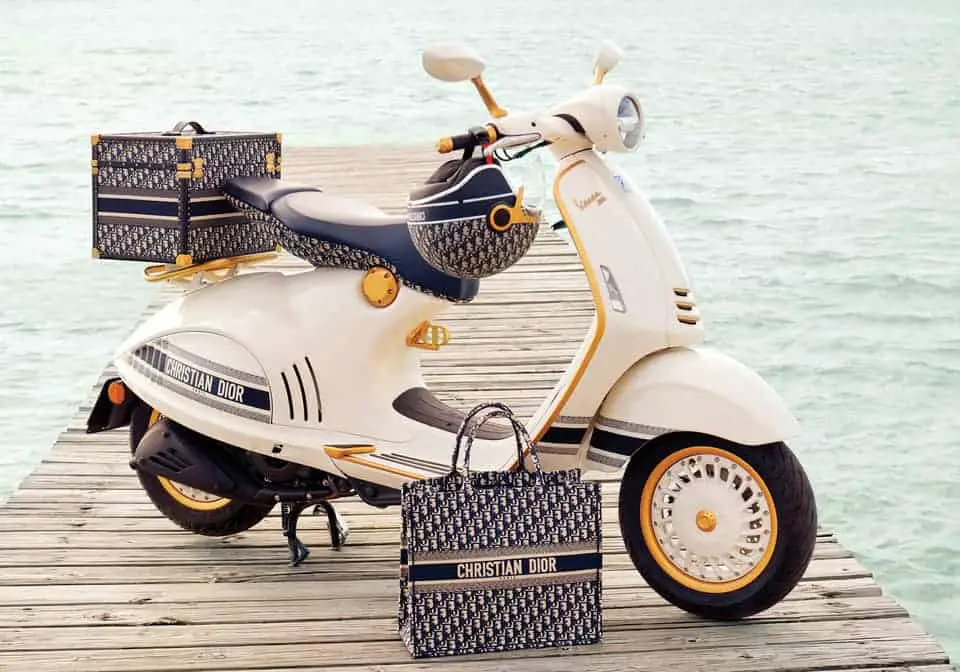
Vespa is born in a country where style is a way of life. Italians have an eye for beauty. Just think of Lamborghini, Ferrari, Maserati, Gucci, Armani, Prada, Versace, and the list goes on. It’s actually not a surprise that Vespa isn’t just loved for the sense of freedom, but for its looks too.
Today the Vespa is found everywhere. They are not only used as a classy form of transportation, but they are at weddings, in fashion shoots, magazines, social media, window dressing for shops, etc. It is a stylish vehicle that looks classy and has the word “happiness” written all around it.
Except for style, people are able to portray their own image together with the Vespa. Men driving a Vespa dressed in an Italian suit, or women with skirts and high heels driving or posing with a Vespa. Heads will turn no matter which Vespa model.


In some countries driving a Vespa is a ‘status symbol’. For the ordinary Italian, a Vespa is quite expensive when you add up the expenses for insurance and maintenance. Not everybody can afford it anymore. Same in other countries. A Vespa 946 costs $10.000 in the USA! And in Indonesia, the latest Vespa GTS Super Tech 300 is around $10.573 US. So much money when you consider the average income is $850 US. So you can imagine, people will look when you buzz by.
Luckily the Vespa isn’t only about status. It is also a way to express yourself. You can see that when a custom Vespa drives by. Some of them have subtle modifications, but there are many where you can only distinguish the shield and headlight.
Custom-made Vespas also show the style that the owner wants to portray. This was particularly evident in the 1950s in the United Kingdom where the Vespa was part of the stylish mod subculture. The movie Quadrophenia (1979) shows the lead player Jimmy searching for his identity among the mods. The Vespa is one of the main scooters in this film. A mod Vespa is characterized by a small windshield together with a lot of headlights and rearview mirrors.
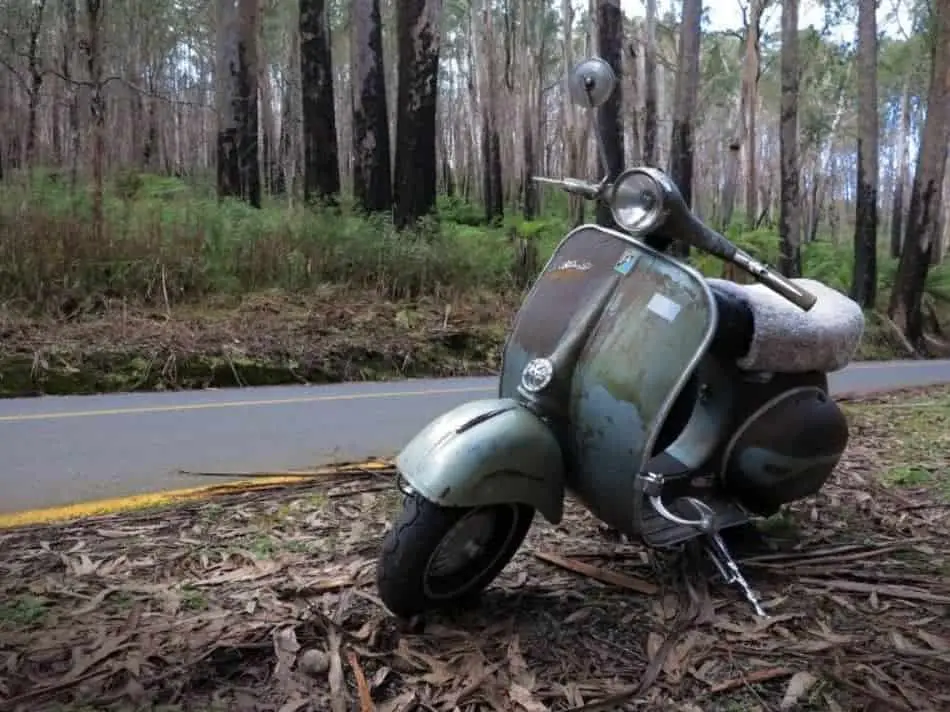
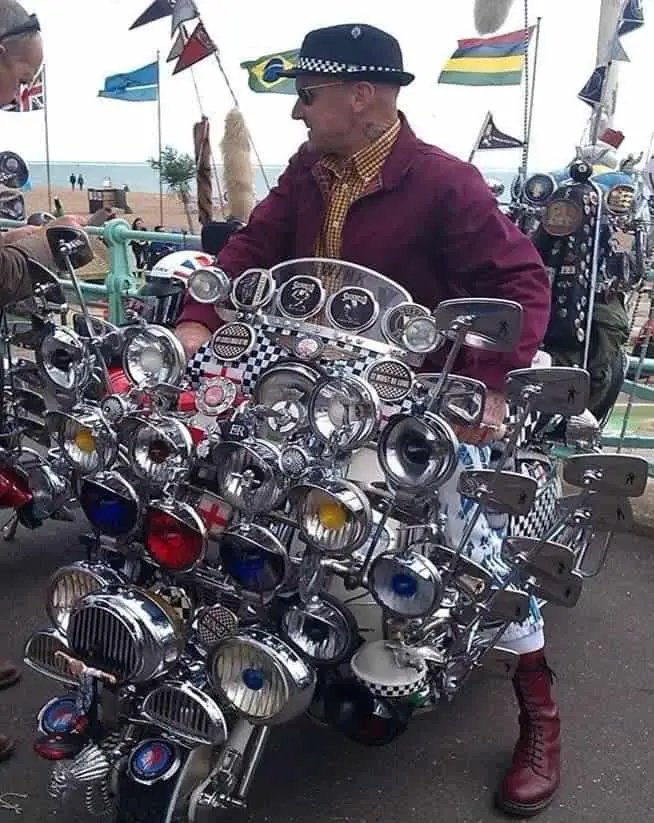

However this case it is not only a sense of style but also a way to express yourself. Today there are still many Vespista who like to express themselves. There are those who like to stick to the rusty rat scooter or those who customizing their Vespa to the extreme. This happens in Indonesia a lot and no wonder you’ll find the second biggest Vespa fan club in the world here.
The increase of ‘vintage’ and ‘nostalgia ‘ has also pushed Vespa back on stage. Nowadays people are seeking to step away from the digital world and like products that are not produced in mass numbers. The Vespa is a way to be more unique just like vintage clothing, vinyl records, restored furniture. Classic Vespas are highly sought after and they are often restored again.
6. Vespa had collectible calendars
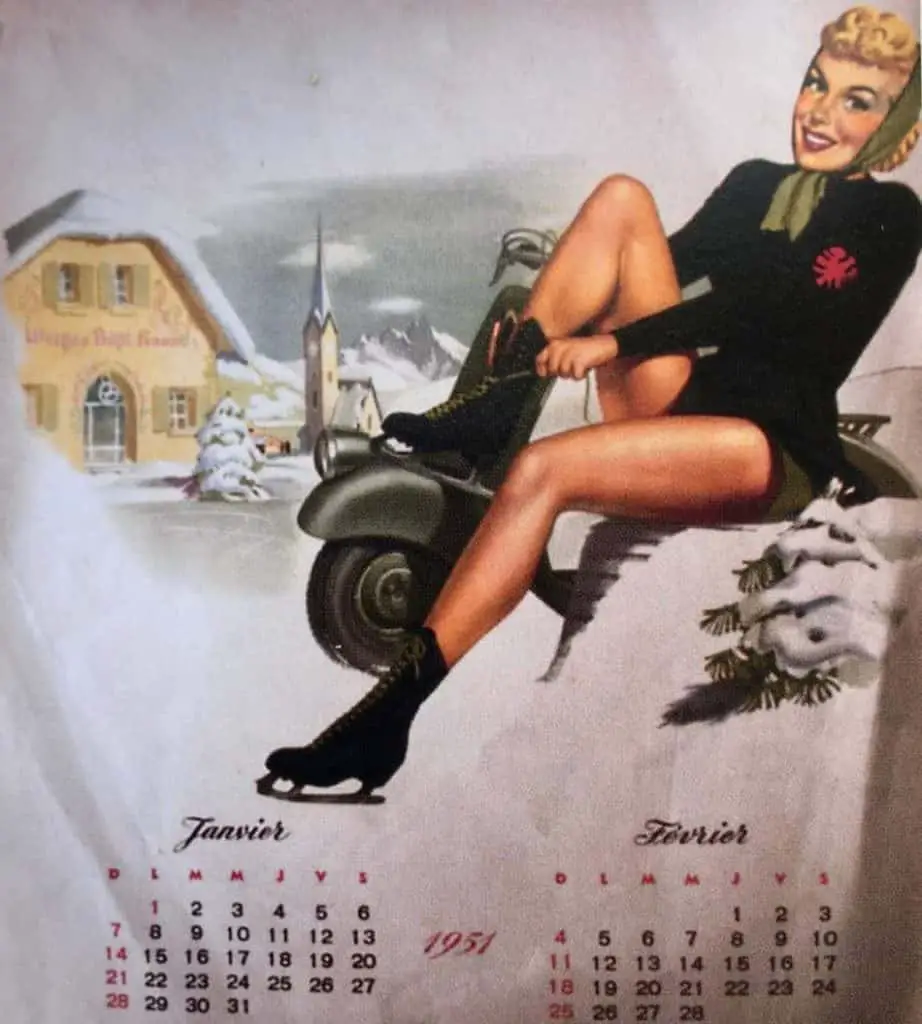
Piaggio was also able to popularize the Vespa in another market: calendars. They were very smart at creating calendars of girls with Vespas. And not only just girls but beautiful and sexy girls. At that time it was pretty shocking and it was seen as a scandal among catholic Italians.
But it became a success of course.
It started in 1951 when the drawings on the calendars were made by Franco Mosca. These are famous and the drawings are still used on other Vespa accessories and decorations.
Later on, in 1955, the girls were photographed with the Vespa. Each year the calendar appeared in different themes. One year it was sports and travel while in the other year it was nature.
From 1957 the girls and their Vespas were photographed while the background was drawn, giving it a different yet pretty artistic effect. In 1959 the background was plain, emphasizing the subject of the calendar: beautiful women and her Vespa.
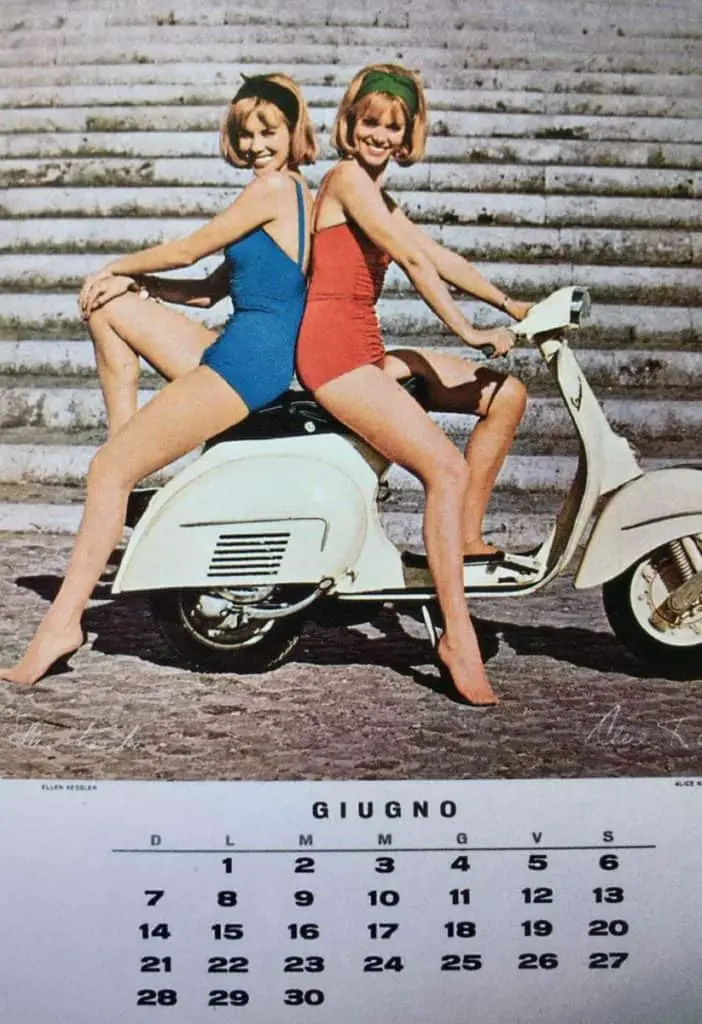
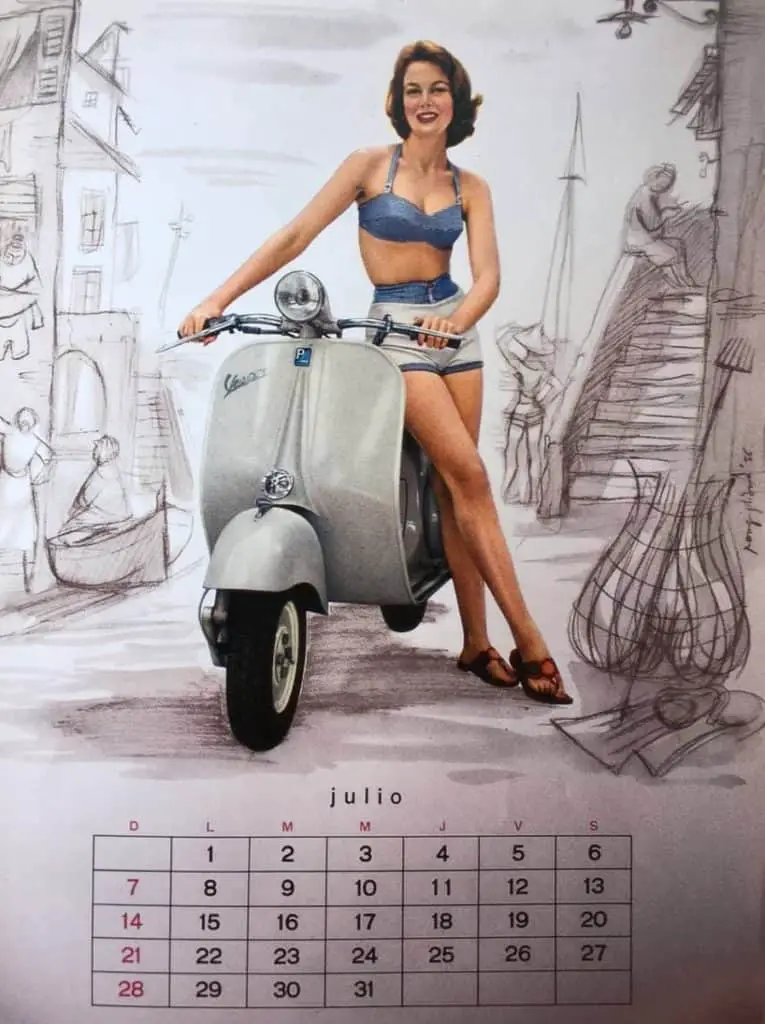
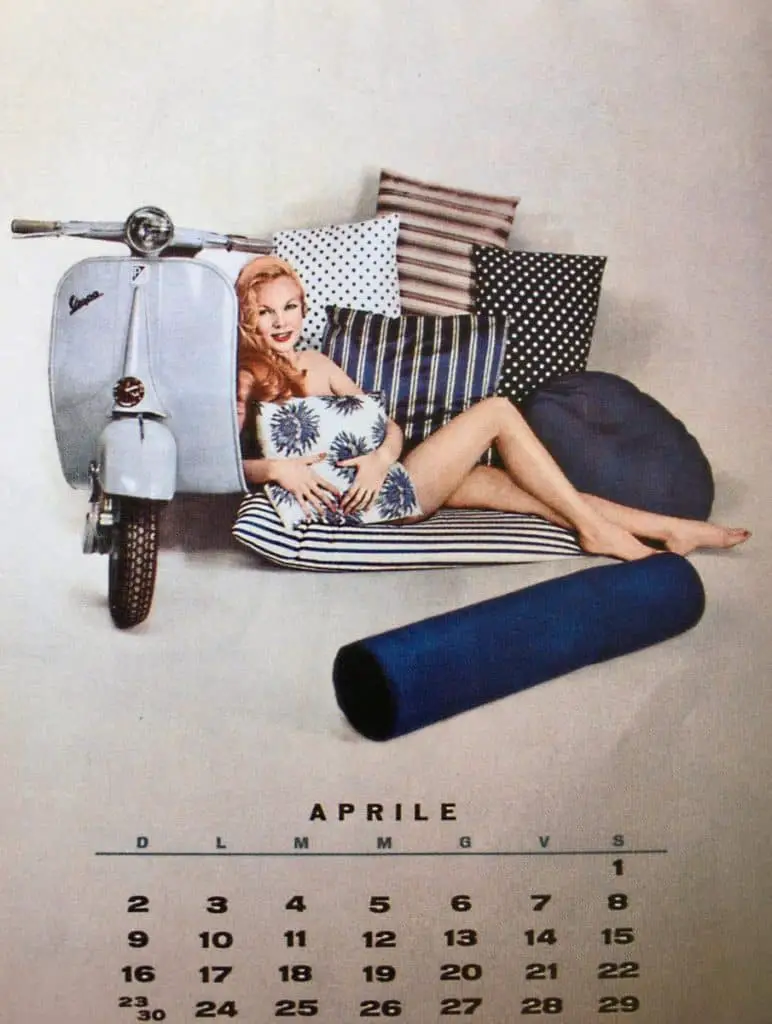
From 1966 Piaggio used models and actresses for their Vespa calendars. Since these calendars were so popular it must have been an honor to be selected.
The Vespa calendars show changes over the years. Not only the Vespa models, but you can pretty much see the current trend at that time, how women were pictured and what was in fashion at that time.
The calendars remained popular till 2000. Perhaps today they are outdated since computers and mobile phones have calendars too. There are still a lot of calendars with Vespas for sale, but not officially created by Piaggio.
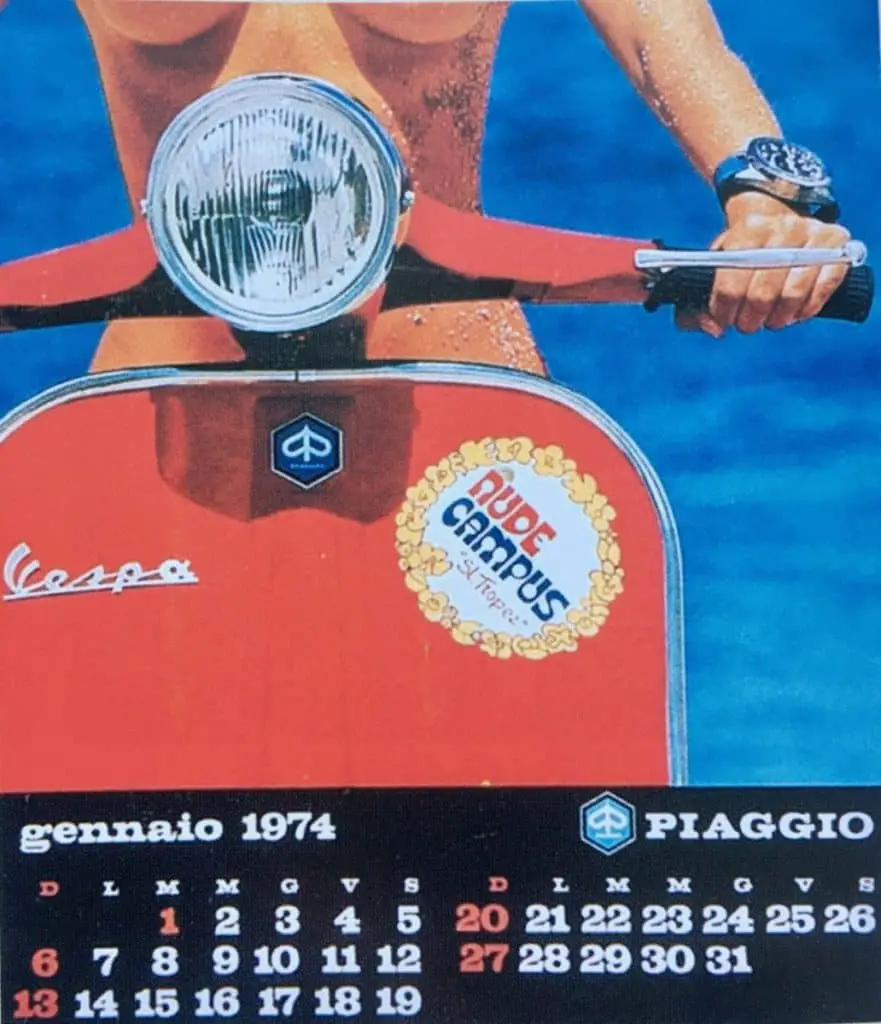
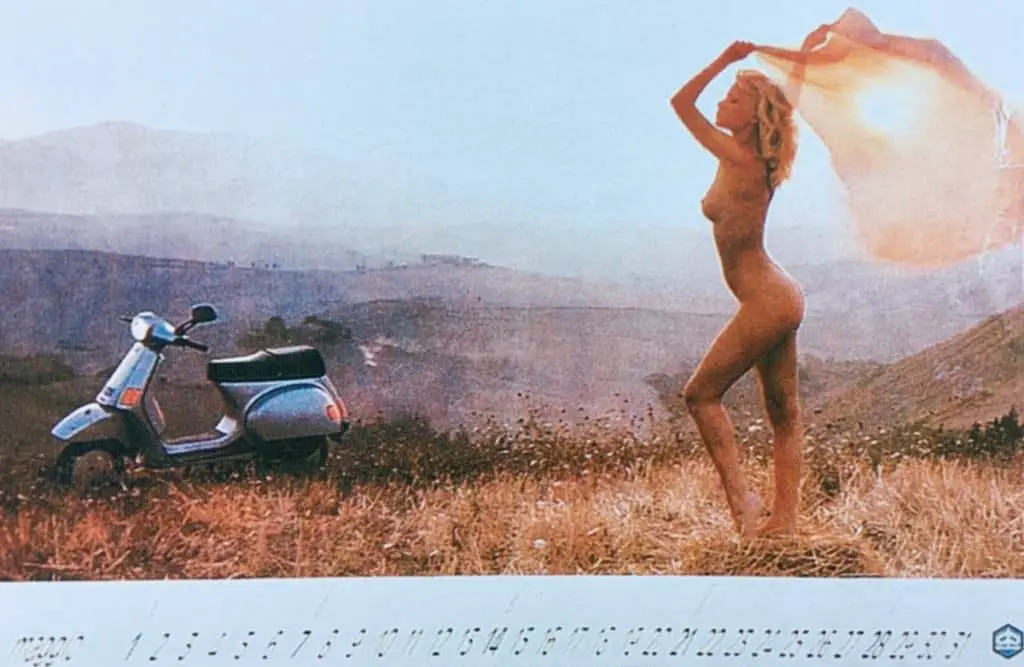
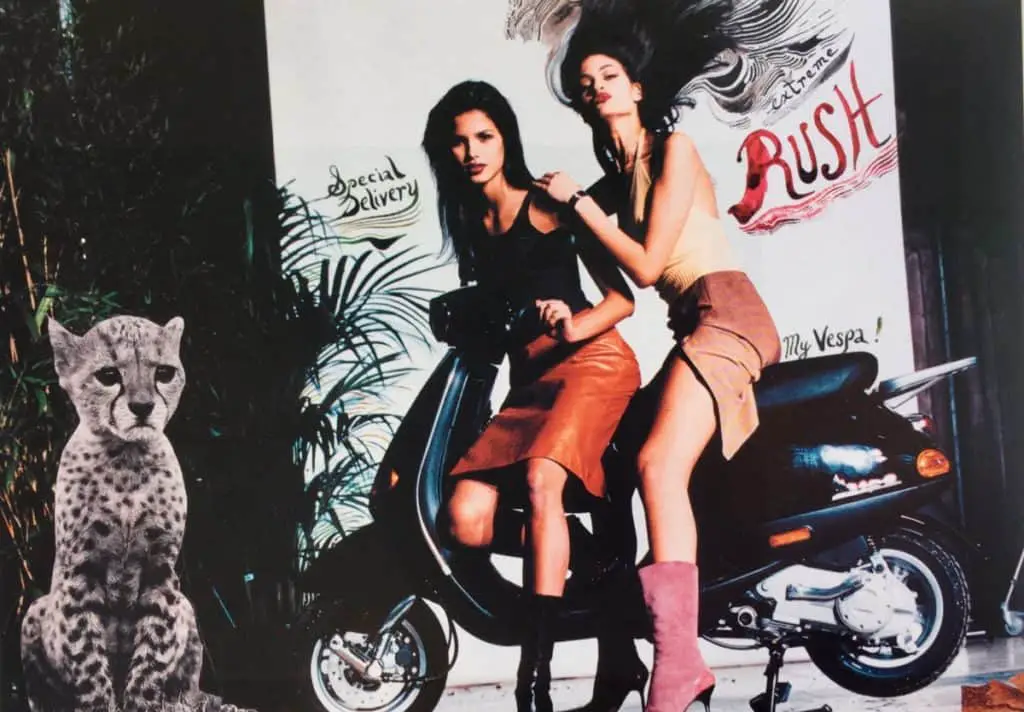
7. Vespa clubs create comradery
In the 1950s everywhere in Italy, there were groups of Vespista riding out together, touring around the countryside. Soon enough in 1953, Piaggio started to organize these clubs more professionally. The Vespa Club d’Italia organized various conferences for the clubs, distributed news publications, and organized various activities.
On the 10th anniversary of the Vespa Club d’Italia, they already had 220 Italian clubs with more than 50.000 members.
When Piaggio started to sell Vespas worldwide, soon there were Vespa groups in almost every country. In 1954 Vespa Club d’Europe brought Vespista together from various European countries. It was a huge success. It became the largest and most famous rally.
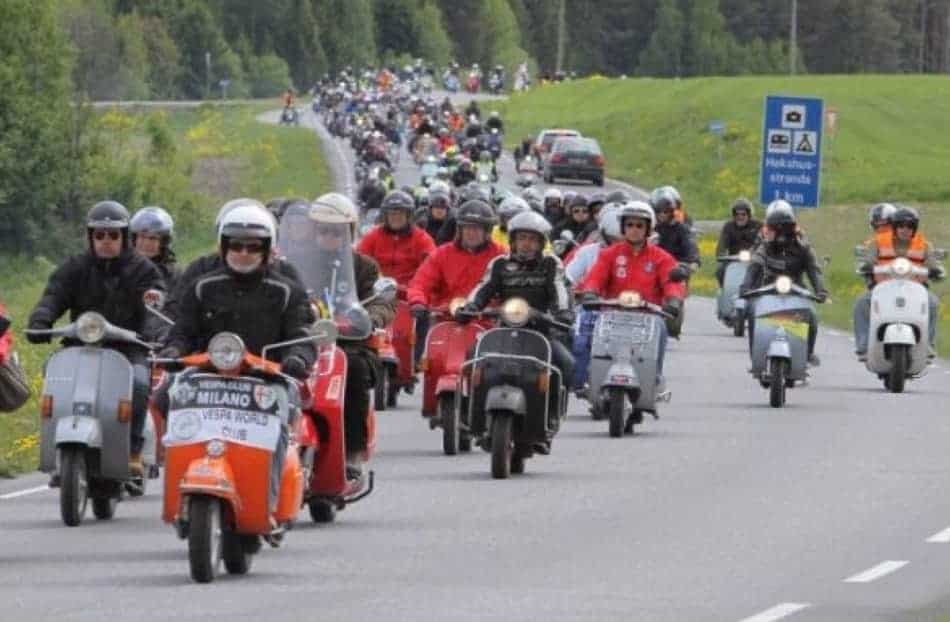
In 2006 the Piaggio foundation changed EuroVespa into the World Vespa Days. From all corners of the world, people come together to celebrate the joy and passion for Vespas. And to show off their own Vespa of course.
For 2021 it is planned to be organized in Switzerland. However, considering the COVID-19 travel restriction, this is very unlikely.
Not only have the clubs been important for commemoration but the Vespa Club d’Italia has ensured that historical models have been conserved and valued too.
8. New Vespa models have up-to-date technology
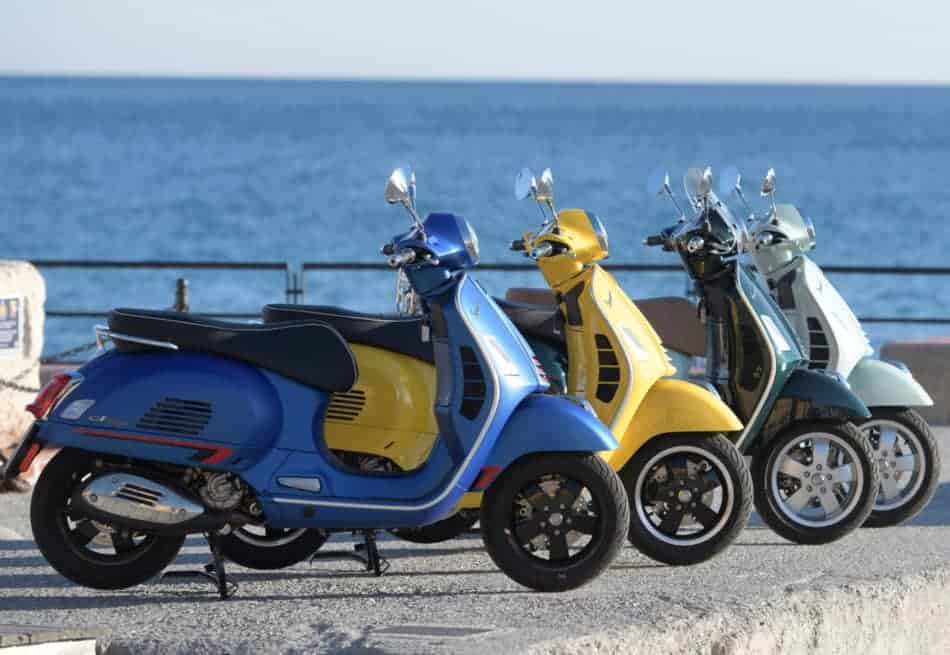
Throughout the history of the Vespa, Piaggio has always tried to improve the mechanics of this iconic scooter by increasing the engine’s performance and driving safety.
The first Vespa came with a 98cc engine displacement. The second Vespa with a 125cc engine displacement and nowadays the Vespa GTS comes with a 300 cc engine displacement. However, the technology used in the last years is very different compared to the first models.
Piaggio has relied on the 2-stroke engine until the launch of the 4-stroke Vespa ET in 1996. The 4-stroke is more economical and produces less pollution than a 2-stroke engine. Furthermore, most of the latest models have HPE (high-performance engines) and the Vespas come with ABS (automatic braking system). Also, they come with 4.3 inch TFT screens and there’s the MIA App that you can connect to your smartphone through Bluetooth. This way you can view navigation data and get other travel statistics.
Piaggio has even made sure the eco-conscious Vespista are satisfied with the latest model. The Vespa Electrica is a zero-emission scooter that not only comes with a long-range battery but is also very silent and as Piaggio says ‘technologically savvy’.
As you can tell, despite being 75 years old, Vespa has always kept growing together with the wishes of the public. Whether it is its design, lifestyle, technology, or safety standards. The combination of all these factors makes Vespa so popular.
